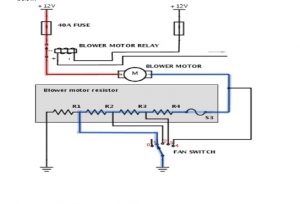In the center of a vehicle’s HVAC (Heating, ventilation, and air conditioning) system lays a blower motor that is used to drive the fan and produce air-fluid in the cabin you stay in. It often locates inside the glove box or engine compartment (for some old vehicles). Regularly, the blower motor is pulled up with a thermal fuse to prevent effects from overheating instances.
The blower motor resistor is implemented to control the wind speed by regulating electricity current to the fan except for the highest level of speed. Because resistance raises the heat to the circuit, it is often mounted near the blower motor so as to gain cooling across the airway.
How does a Blower Motor Resistor Work
The working schematic of a blower motor resistor can be displayed in the graph below:
As the diagram depicted, the blower motor resistor and the fan switch are both connected to the ground. And the blower motor has its positive terminal connected to a 12V supply as long as its negative terminal is connected to the motor resistor.
The fan switch has 5 gear positions: When it turns position-0, it forms an open circuit and the fan doesn’t work; From position-1 to position-3, the motor resistor unleashes decreasing resistance and by the other hand, the circuit is delivered by increasing current, which results in higher speed of the fan; On position-4 (the highest fan speed setting), the motor resistor is bypassed and the blower motor is fed by power directly from the ground.
Symptoms of a Failing Blower Motor
Symptoms that denote demanding repair or replacement such as no air, “stuck” on one level of speed, and so on, should call drivers attention:
- Only Working at Higher Speeds or Lower Speeds
It happens when some of the resistors fail in the control module so the current won’t be modulated by the expected speed settings. Additionally, when some disorders happen to the circuit between the motor resistor and the blower motor itself, it is likely to see the blower motor work only at low speed.
- No Air from the Vents
This sign can result from several issues like switch or wiring faults, broken thermal fuses, and a bad ground.
- Fan cannot be turned off
It stems from similar reasons for the first problem.
- Smokes comes out of the vents
Although it doesn’t seem to be the motor resistor’s faults, short circuits or even more serious issues may take place somewhere under the dashboard.
- Burning Smell
This always comes along with some other symptoms listed ahead. Overheating brought by jammed fan blades contributes to the situation most of the time.
Maintenance, Test and Replacement for a Blower Motor Resistor
- Maintenance
To ensure your year-comfort with your family or colleagues, you should do routine care and maintenance before the weather gets hot. Remove and clean the motor fan to avoid dirt or something else that may obstruct the blades; Replace the air cabin filter of the vents for a similar reason as what we do to the motor fan; Lubricate the motor competently to guarantee the efficiency of the revolving mechanical parts.
- Test
When malfunctions occur to your car’s HVAC system, before turning you’re your car directly to the local mechanic shop, these are some tips you can follow sequentially.
- Turn to the service manual. The most straightforward way you should consider in the first place is to look into the service manual from the vehicle manufacturer, on which instructions are demonstrated specifically to the exact series of vehicles and current conditions.
- Start the self-diagnosing mode. Recently, many advanced vehicles have been equipped with the self-testing mode that functions to diagnose the possible failure of the whole HVAC system including the blower motor. At the end of the procedure, a bug code is supposed to show up to which you can refer to the service manual.
- Check out under the control knob and inside the hood on the passengers’ side for any troubled applicable fuses or relays; though, the chance is relatively low that it is the faulty part.
- If none of the above diagnoses shows any abnormity, the problem may have something to do with the blower motor resistor (or the motor control module). Firstly, inspect the resistor kit visually to see if there’s corrosion on the surface. If not, verify power to the blower motor and ground to the switch and resistor by using a multimeter. To put it simply, if any measurement of the resistor’s input terminals comes out as infinite or extremely high resistance, which indicates an open circuit, the blower motor resistor (or the motor control module) has failed and needs replacement.
Be careful handling the resistor! Significant heat may have arisen due to surging currents that pass through the circuits.
Replacement
Unfortunately, the situation leads you to the last resolution to the problem. Nonetheless, it might be an excellent opportunity to take a lesson by do-it-yourself. Don’t forget to put on safety glasses and latex gloves or other safety wear first!
- Remove the negative battery terminal.
- Remove the glove box door to access the location of the blower motor. Usually, you can get a common-use tool to manage that.
- Disconnect the motor belt and demount the screws.
- Replace the faulty motor resistor with the new one.
5.* Reverse the process 1-3.
Summary
In this article, Easybom has walked you through actually how a blower motor resistor plays its part in controlling the fan speed of the blower motor and what symptoms you may come about when using it. Also, we discussed examinations and trouble shootings for it. We are more than joyful if this helps you.





























